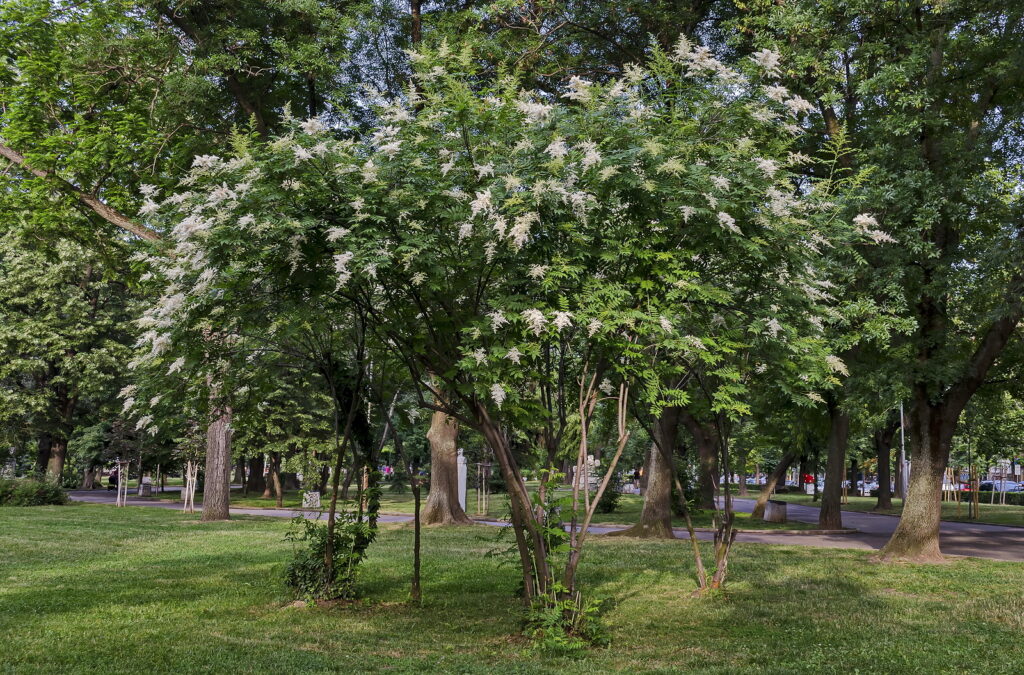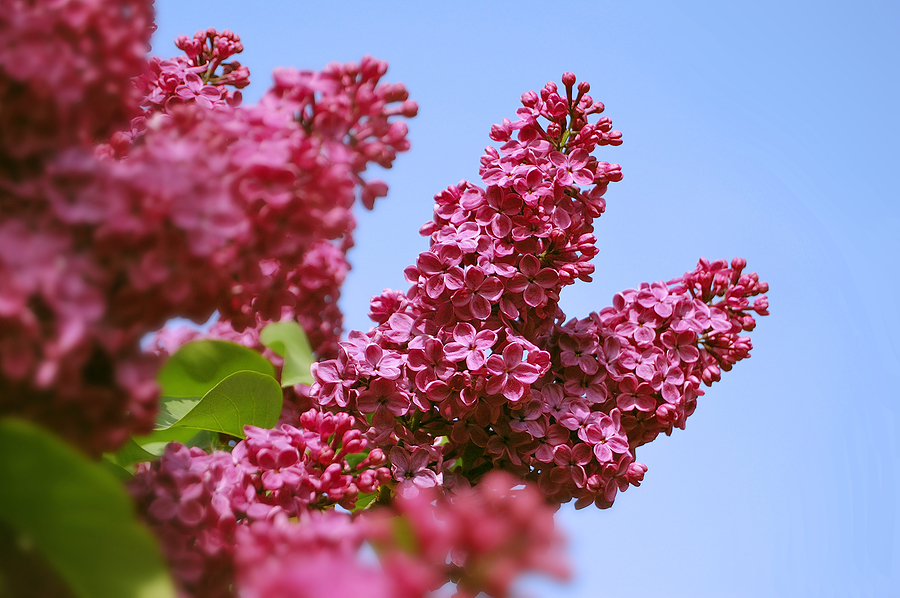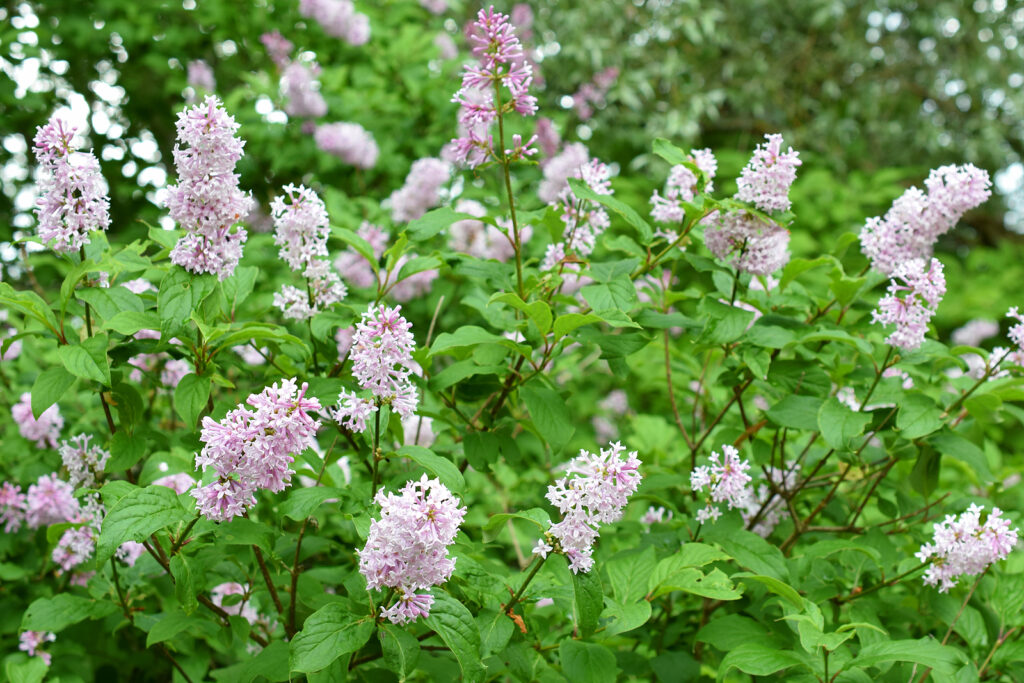Syringa–commonly called Lilac–bears large conical clusters of highly fragrant purple, pink, and white flowers. Lilac is a deciduous shrub with mid-green heart-shaped leaves.
Lilacs are mostly large hardy shrubs of easy cultivation, free-flowering, and very ornamental bloom. The flowers are born in large panicles, ranging in color from pure white to deep crimson, through many shades of lilac, with some near pink and blue. Flowers may be single or double and are usually very fragrant.
The common lilac is one of the best-loved shrubs and is often found in the countryside marking the site of a former dwelling. More than 200 named forms of this old favorite have been developed. Besides these, there are several good Asiatic species that extend the season of bloom.
Lilacs are good-natured and tolerant of almost any soil and situation but thrive best in rich, well-drained soil and an open situation. they appreciate lime and respond well to applications of bonemeal and dressing of rotted manure from time to time.
Should a lilac get overgrown and scrawny, it can be completely renovated by being cut back almost to the ground in early spring.
Syringa is a genus of 20 species of deciduous shrubs and trees from woodland and scrub from Southeastern Europe to East Asia.

Get to know Lilacs — Syringa
- Plant type: Deciduous early summer-blooming shrub
- Growing Zones and range: 3-7
- Hardiness: Hardy
- Height and width: To 20 feet (6m) tall and 12 feet (3.6m) wide
- Foliage: Heart-shaped leaves
- Flowers: Very fragrant flowers in long clusters, commonly lavender, but cultivars with white, pink, or blue flowers
- Bloom time: Spring and early summer
- Uses: Specimen shrub, shrub borders, screens, or hedges
- Common name: Lilac
- Botanical name: Syringa spp.
- Family: Oleaceae
- Origin: Southeast Europe to Eastern Asia
Where to plant Lilacs — Syringa
- Grow Syringa in full sun to light shade.
- Grow Syringa in average to humus-rich, neutral to somewhat alkaline, well-drained but moist soil.

When to plant Lilacs — Syringa
- Plant Syringa in spring or fall.
Planting and spacing Lilacs — Syringa
- Space Syringa 8 to 10 feet apart.
How to water and feed Lilacs — Syringa
- Syringa needs moderate moisture; keep the soil evenly moist
- Fertilize Syringa by side dressing around plants with aged compost in spring and summer.
Lilac — Syringa care
- Mulch around Syringa to conserve soil moisture.
- Do not prune small types of Syringa.
- Prune large Syringa each spring after flowering; remove one-third of branches from older, larger types at ground level; also cut out all suckers.
- After several years, rejuvenate Syringa by cutting all branches to about 1 foot high.
- Older Syringa varieties are prone to mildew in humid regions.
Lilac — Syringa common problems
- Syringa is susceptible to powdery mildew, leafroll virus, Verticillium wilt, and bacterial leaf spot.
- Insects that may attack Syringa include borers, scale insects, and caterpillars.

Lilac — Syringa propagation
- Take Syringa cutting in the fall.
- Layer Syringa in spring.
Lilac — Syringa varieties to grow
- Syringa patula, Dwarf Korean lilac including ‘Miss Kim’ is good for small spaces and grows to 2 to 3 feet tall in Zones 3-8.
- Syringia vulgaris, common lilac, can top 20 feet and suckers prolifically. ‘Lady Lavender; bear lavender flowers; ‘Miss Ellen Willmot’ bear double white flowers; ‘President Lincoln’ has single blue flowers; ‘Sensation’ has wine-red flowers edged in white.
Lilac frequently asked questions
Q: What kind of soil and fertilizer do lilacs need?
A: Lilacs prefer a well-drained and slightly alkaline. You can feed lilacs every other year with aged cow manure. Sprinkle lime around the plant in spring; add fertilize with manure in the fall.
Q: How do I prune a lilac?
A: Prune out most of the young suckers and all of the dead or diseased wood. Prune out some of the older branches to allow more light to reach the remaining branches. Prune just after blooming.
Q: My lilac is 10 feet tall. How can I get down to eye level where I can see the flowers?
A: You can cut the plant down to 2 or 3 feet above the ground and let the plant start over. A less drastic method is to thin the plant back by one-third each year. The second method will allow for continuous blooms. Prune right after the plant finishes blooming.
Q: When is the best time to plant or transplant lilacs?
A: Lilacs are among the easiest plant to transplant. They can be planted in spring or fall. They will grow under almost any conditions.
Q: Can I move a large lilac?
A: Yes. Prune the branches back by one-third then lift the plant with a large ball of soil around the roots to move and replant it.
Q: Will lilacs bloom in partial shade?
A: Lilacs need sunshine. The less sunshine they have the fewer the flowers.
Q: My lilac had few flowers last year. What’s the problem?
A: Some lilacs are alternate-blooming; they flower profusely one year and sparsely or not at all the next. When lilacs fail to bloom, there are a few things you can do: (1) thin out some of the branches at the base of the plant; (2) apply lime if the soil is acid; (3) dig a 2-foot ditch around the plant, root-pruning the plant; when you return the soil to the ditch add in some superphosphate–about 8 ounces for every 3 feet to ditch.















